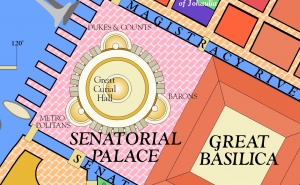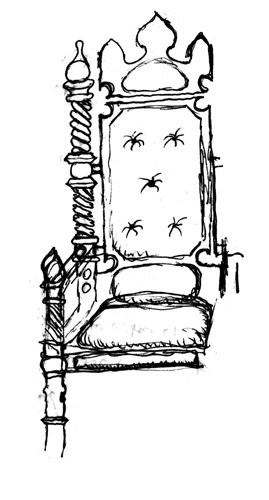Noble Senate of Aurice
The Noble Senate of Aurice is one of the oldest surviving aristocratic assemblies in the history of the Pallathantic Region. Its origins are traced back to the late fourteenth century when the ruling merchant families of the many-isled city convened to cooperate and form the first central government. The senate's powers over the city grew and the city's merchant class, closely associated with the senate, extended their power over the neighboring islands and Goscundy over the following centuries until it became the de facto power in Lucacia. In 2627, the Noble Senate declared sovereignty and abolished the grand ducal monarchy. The independence was confirmed in 2634 with the Battle of Kadraskan. The Noble Senate remains today as the sovereign ruling body of the Aurician Empire with the power to establish and appoint all officers of the Noble Republic of Aurice and direct power over the city of Aurice, although this is typically delegated to governors. By condescension, the Noble Senate acknowledges the viceviles elected in the vicifs in the capital city. The word 'thronarchy' is rather informal and somewhat disrespectful term for the Noble Senate which alludes to the high thrones on which the Senators are seated when in formal session.
Senatorial Sovereignty
Unlike other traditions where the peers are considered dependent upon the sovereign monarch, the Noble Senate of Aurice has traditionally been sovereign, using its power historically to appoint a governing duke to lead in matters of warfare and to receive diplomatic envoys. The sovereign status of the Senate was lost on these occasions: during the rule of the First Kalikán Empire, the rule of Prince Ulcanov of the Shattered Waters, the rule of the Medibgóëse Prince-Governors, the rule of the Vice-royal Dukes of the New Kalikán Empire, and the subsequent rule of House Bijäl during the Grand Duchy. The Aurician Revolution in the twenty seventh century restored the historic sovereignty to the Noble Senate after over five hundred years of monarchical and imperial rule. Before this time, the senate after the First Kalikán Empire was sovereign up to the period immediately before the reign of Prince Ulcanov, sovereign during the period of 2290 to 2477, and lastly sovereign from 2627 to the present.
Although styled sovereign, the Noble Senate today shares some of its powers with the Provincial Curia and the provincial parliaments. In 2722, the powerful corpora mercia of Aurice demanded representation in the Senate, inspired in part by the Narsadese Shu'ah composed of mercantile entities. Their demands were staunchly resisted by both the Noble Senate and the Provincial Curia, but the influence of the corpora mercia persists in the empire and the organs of government.
Composition
The Noble Senate is composed of members or peers who hold the office of senator and one or more noble ranks. Traditionally, the noble ranks of Aurice, similar to Lucacia, are hierarch, duke, count, baron, and metropolitan. The rank of metropolitan was created in 2559 by the Thracian Vice-royal Duke Baimund Kaligär with the intent of diluting the power of the other peers in order to make the senate more pliable to his policies. Unlike the other noble peerages, only a minority of Aurician Metropolitans hold the office of senator. The High Phœnissa becomes a duchess in her own right upon ascension and is made a senatrice with full powers. She also possesses prerogatives typical of a hierarch. Other high officers of the government on rather rare occasion may be ennobled by the senate, although they are often already members of the senate. Typically a long and successful career as a military commander is the most common way to be deemed worthy of ennoblement.
The senators are drawn from numerous aristocratic families whose emergence into the ruling class reflects the changing fortunes of the city of Aurice through the centuries. Most families are of ancient, native Lucacian blood, but a large minority are drawn from Thracian ancestry, having obtained their ranks from the Kings of Thrace or more often from the Vice-Royal Duke appointed by the King of Thrace during the twenty fourth and twenty fifth centuries. Of those remaining, some are Incarnandist Shaphrizite from the time of the Fifth Isbajath and others of Medibgösk ancestry, with the smallest portion belonging to Ersercese and other neighboring lands whose members purchased their offices from the ruling duke, usually with the assent of the Noble Senate.
Senatorial Powers
The Noble Senate of Aurice has power to deliberate and create new legislation. The senate appoints the highest ranking officers, including the Lord Governor-General of Aurice. Despite its sovereignty, the senate has been compelled to share some powers with the Provincial Curia, including the selection of the Lieutenant Governor-General of Aurice. By condescension, the senate recognize the viceviles elected in the vicifs of the city. The senate may refuse to allow any vicevile to be seated and could even abolish the office of vicevile at large, although this is unlikely due to the popularity of the viceviles.
Senatorial Palace of Aurice

The Noble Senate may conduct its business in any locale it chooses, but it rarely does so other than in the Senatorial Palace. On some rare occasions, it has conducted business in the throne room of the Gubernatorial Palace of Aurice, in the Temple of Aurice (Gubernatorial Palace), and in the Temple of the Golden Phœnice. The construction of the Senatorial Palace took place over a sixteen year period, from 2634 to 2654, using titancraft engines to hasten the work. The Great Curial Hall by far is the largest chamber in the palace and the setting for the central Mensary where the senatorial peers meet. The Senatorial Palace rests on the east bank of the Golden Phœnice Riven across from the Gubernatorial Palace.
Mensary
The Mensary is the circular podium in the middle of the Great Curial Hall of the Senatorial Palace. There is a depressed, circular ambulatory around the mensary and it is necessary to cross from the outer gallery to the mensary over a bridge.
The thrones of the senators rest on the mensary and this is where the senators sit when in formal session of the senate. The height of the seat of the throne is determined by the noble rank of the senator, with progressively greater height for barons, counts, dukes, and finally hierarchs. It is necessary for some senators to climb a ladder to sit in their thrones. It is possible for a senator to have his eldest son sit symbolically in his throne, especially if the senator himself is infirm and cannot climb the ladder. One senator of great girth was famously hoisted into his throne. The height of the back of the throne is also greater based upon the office, if any, held by the senator. The backs of the thrones for the holders of the offices of Lord Governor-General and the High Phœnissa are the highest. The backs of the thrones for the offices of various hierarchs are the next highest.
Senators during sessions will use subtle hand gestures meant to appear as natural movements to express their approval, disapproval, or commentary during the speech of a member. These gestures are called Mensary Cant.
See Also
- Aurice
- Aurician Parliamentary Reforms and Expansion of Suffrage
- Aurician Senator
- Aurician Social Classes
- Government of Aurice
- Grand Duchy of Aurice
- List of the Rulers of Aurice
- List of the Senatorial Houses of Aurice
- Mensary
- Noble Republic of Aurice
- Senatorial Palace of Aurice
- Thronarchy
| This article is a stub. It requires further development by the creator. |
